I remember watching pumping iron for the first time in high school and being blown away by the size of Arnold’s chest. His chest was incredibly full and so thick that when he hit his side chest pose, it looked like you could balance a drink on the top of his chest.
At the time, I couldn’t understand how someone’s chest could be so thick even right at the clavicle. Once I tried incline bench pressing at the gym, I felt DOMS (delayed onset muscle soreness) like never before and began to understand.
The pectoralis major comprises two heads, the sternal and clavicular. The clavicular head is commonly known as the upper chest; as inferred by its name, it runs up to the clavicle, while the sternal head is known as the lower chest.
The incline bench press targets the clavicular head and will build a bigger upper chest.
Table of Contents
How To Incline Bench Press Step By Step
Step 1: Unracking The Bar
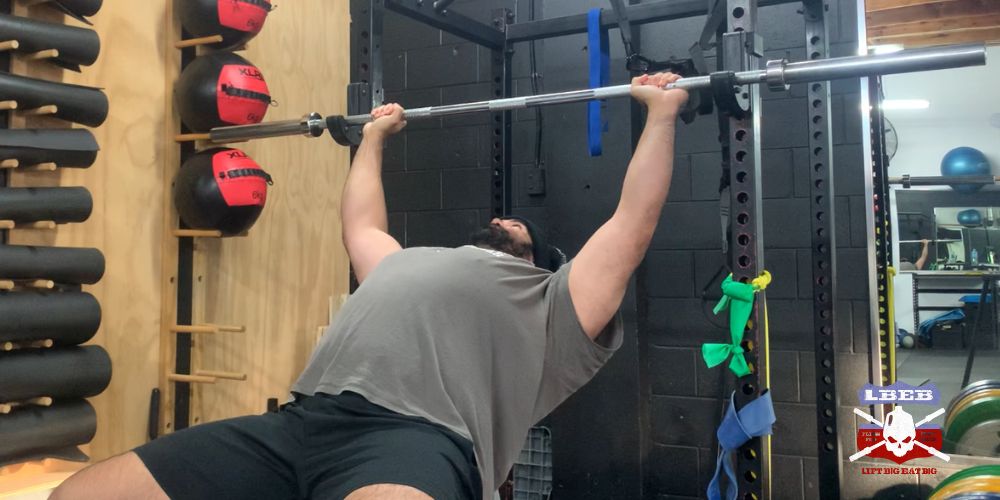
Make sure you are set up on the bench so that you only need to extend your elbows a few inches to clear the J-hooks of the rack.
Setting the rack height too low can lead to some compromising positions for the shoulder or exhausting the triceps pre-lift. I recommend the bar be in line with your forehead. Trying to lift out a heavy weight from behind your head in an incline position is a recipe for disaster.
About forehead height should allow you to have a clear space to press above your head without being intrusive. Upper arms should be about 45° from your body, with elbows only slightly flared.
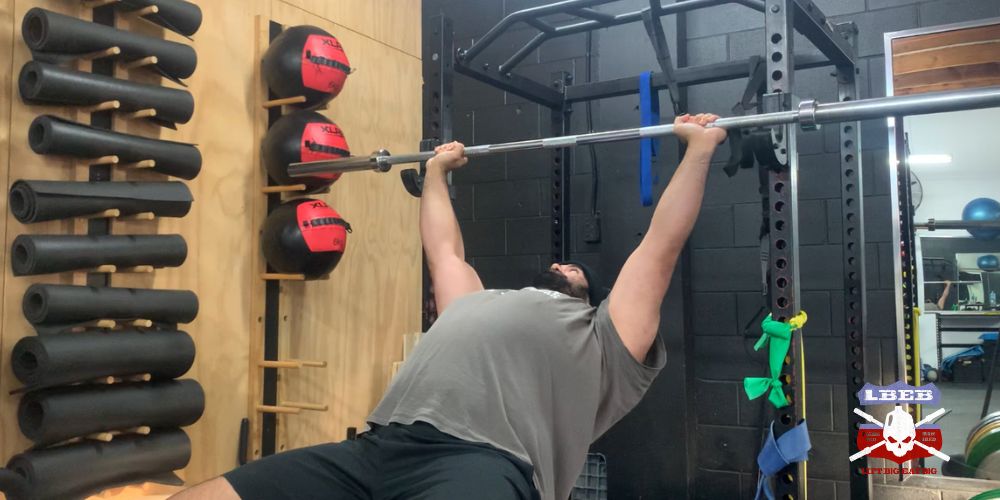
Step 2: Lower The Barbell
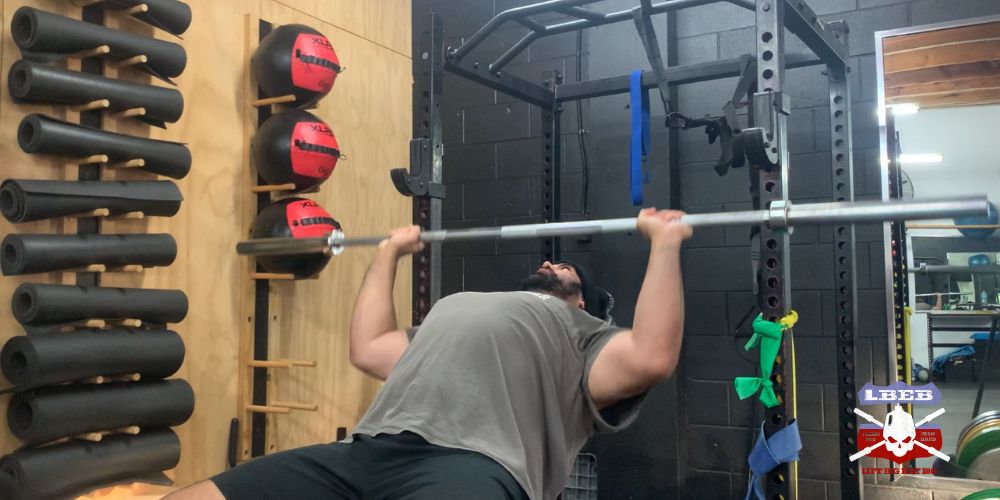
Now you have unracked the bar; you want to lower the bar with control down to your upper chest; your elbows should not be fully tucked into your sides or completely flared out to the side. Ideally, they will be somewhere in the middle, around 45° from your body.
While some old-school bodybuilders recommend flaring the elbows completely and bringing the bar very high on the upper chest (almost to the neck) to get more of a stretch, I’ve found most people cannot tolerate this position; it can be hard on the shoulders and pecs.
You strike a nice mix of safety and strength by flaring to about 45° and bringing the bar down to the middle of your chest.
Make sure when you get to the chest, you don’t relax and sink the bar. Instead, maintain tightness smoothly, do not drop it quickly to your chest or attempt to bounce the weight off your chest. This can be very unsafe, and I have even torn my pec doing so; please learn from my mistakes.
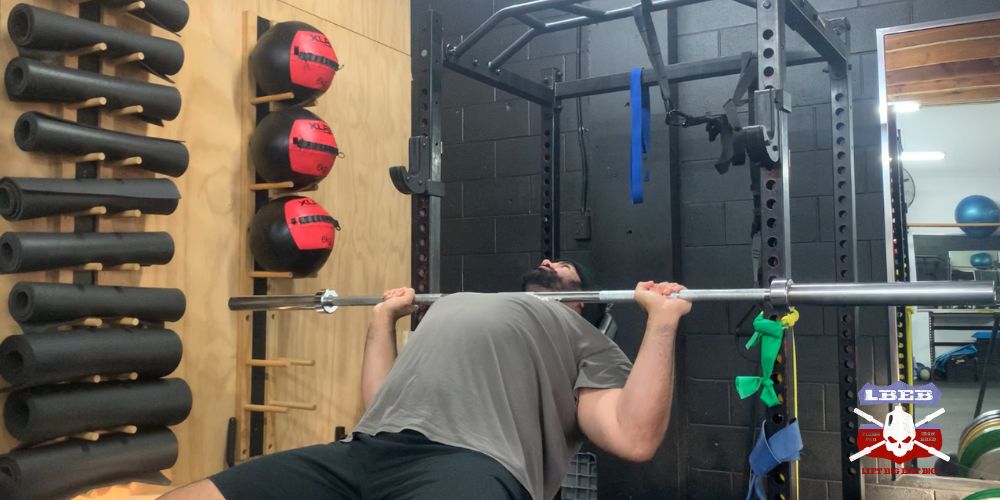
Step 3: Pressing The Bar
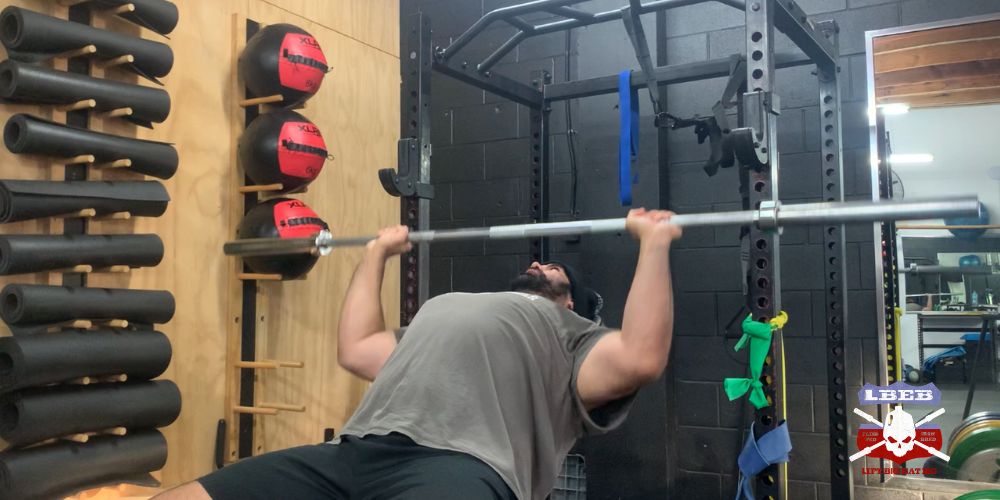
Maintain tightness and explode up, slightly pushing the bar back towards the rack. Aim to press until the bar is directly over your eye line.
The bar path will be a slight diagonal line when viewed from the side. Try to maintain a consistent elbow position throughout the press and avoid excessive elbow flare on the way up.
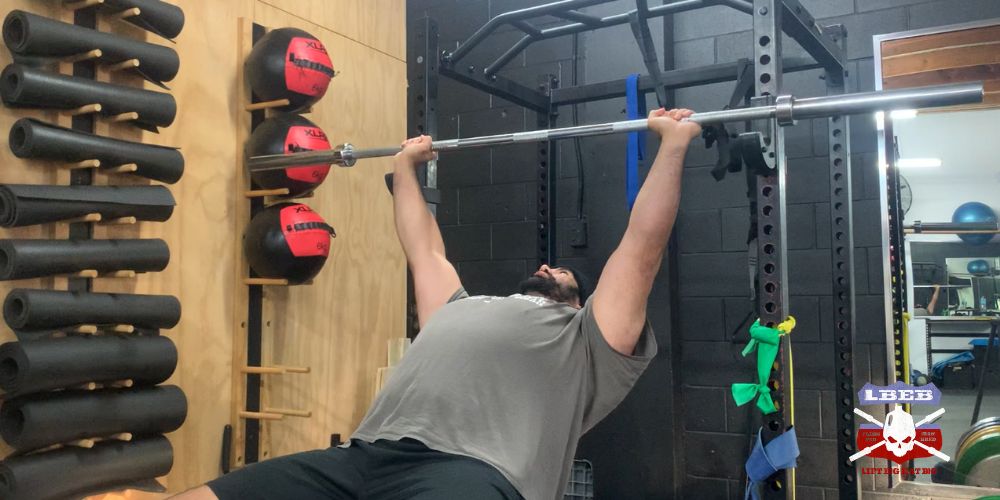
Incline Bench Press Muscles Worked
The incline bench press primarily targets the pecs, anterior delts, and triceps. Changing the angle up or down slightly changes the amount each of these muscle groups contributes.
A study by Rodriguez-Ridao and colleagues looked at five different angles on the bench press, from 0° (flat bench press) 15°, 30°, 45°, and 60° [1].
They found that a 30° incline resulted in the highest EMG (electromyographic) of the upper pecs.
However, increasing the angle led to less upper chest involvement (compared to 30°) and increased front delt activation. Triceps brachii contribution was fairly consistent across all angles.
This means if you want to prioritize your upper pecs, a 30° incline is the way to go. If you want to prioritize the lower pecs, the flat bench is the best, and to target the anterior deltoids, the incline should be higher than 30°.
Incline Bench Press Benefits
Increase Upper Pec Size And Strength
No compound movement hits the upper pecs as effectively as an incline bench press. The clavicular head of the pec is a significant contributor to this movement. The incline bench is a stable compound multi-joint movement.
This means you can consistently load the movement by adding small weights weekly or monthly, depending on your training age.
Consistent progress over time is the best metric for progress, and you can be confident if you increase your incline bench press 8RM significantly, your upper pecs will have grown in size significantly (assuming adequate sleep and nutrition).
High Carryover To Other Lifts
Due to the pecs, shoulders, and triceps being the primary movers for many different pressing options, increasing your incline bench will carry over nicely to other lifts such as overhead press or flat bench press.
I often use the incline bench press to help increase clients’ overhead press as it hits similar muscle groups but allows a much heavier load to be used. There will be fantastic synergy when both an incline bench and overhead press are trained in a week.
Easy To Perform
The incline bench press does not require you to be highly proficient at arching, leg drive, or getting the lats involved, which you may see discussed with the flat bench.
For the incline, lie back, make a proud chest, and don’t chicken wing your elbows. With the incline not requiring a significant degree of technical proficiency, you can focus on progressive overload and get bigger.
Equipment Is Easy To Find
Incline bench is a common exercise; you can find one even if you’re traveling away from your regular gym. If a gym doesn’t have a dedicated incline bench, you can set an adjustable incline bench to 30° and set it up in a safety rack.
Which Bench Angle Should You Use?
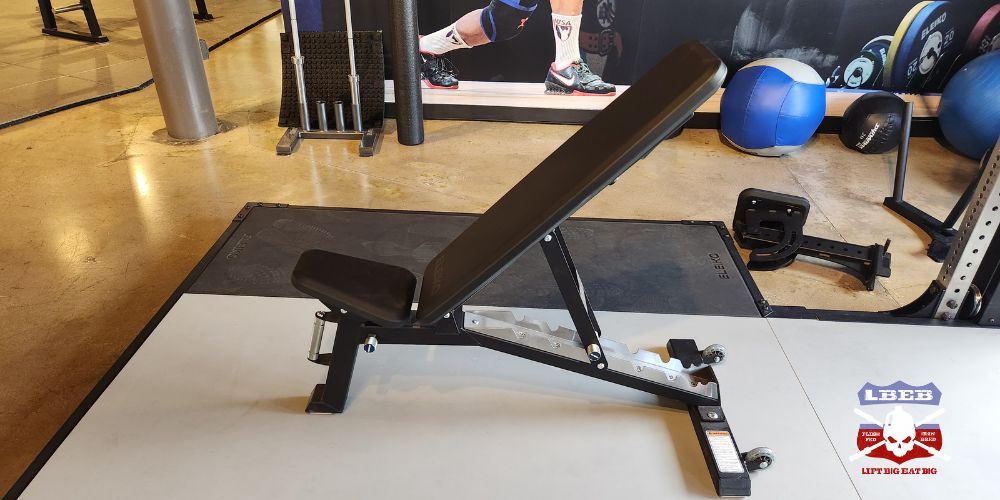
If improving upper chest strength and size is your goal, then 30° is perfect. If you are a strongman or want to improve your overhead press, going to 45° or 60° can benefit you as there is a much higher contribution from the anterior deltoid.
The upper pec will still be involved, but less than when the angle is 30°.
If you are unsure and want to get stronger, I would train the incline at 30° and include an overhead press throughout the week.
That way, you can stress the upper pecs adequately with a heavy load while also improving your shoulder strength and power with an overhead press.
Should You Touch Your Chest When Incline Bench Pressing?
You should touch your chest when incline bench pressing. Studies have examined range of motion in exercises and found that tension at long muscle lengths has led to the best hypertrophy outcomes [2]. This means you should bring the bar down to your chest to allow the muscle fibers to stretch sufficiently.
The one exception to this would be if you have a previous injury preventing you from reaching the last couple of inches toward your chest. If your injury is too limiting that you can’t get somewhat close to your chest, then I would go with a different exercise.
Programming The Incline Bench Press
I recommend using the incline bench on a chest day or upper body-focused pressing day.
The incline should be used near the start of a workout while you are relatively fresh. This will allow you to use a heavy load and create a good stimulus safely.
I recommend doing it after a flat bench press or as the primary chest exercise of the day. While it can be used later in a workout, it means you’re not taking advantage of using as heavy a load as you could if you were fresher and will struggle to build a bigger chest.
Later in the workout, I would use exercises such as flys or crossovers, which don’t require as heavy a load.
Regarding load used, we want to use a weight that is 4 or fewer reps close to failure. To begin the hypertrophy processes, a muscle must experience sufficient mechanical tension, and staying close to failure will ensure this occurs [3][4][5].
Here is a simple progression over 6 weeks
Chest Day (Incline Bench)
- Week 1 – 3 x 10 @7 RPE
- Week 2 – 3 x 10 @8 RPE
- Week 3 – 3 x 8 @8 RPE
- Week 4 – 3 x 8 @9 RPE
- Week 5 – 3 x 6 @8 RPE
- Week 6 – 3 x 6 @9 RPE
This can be done with the incline as the first exercise or the second; as we are going off of RPE, the load you will use will be based on how you feel at that point in the workout.
Ideally, the load will get progressively heavier each week as the volume gets lower. However, if you’re having a bad day outside the gym, make sure you still go off the RPE and don’t get attached to hitting a certain number; this is where injury can happen.
Training in this area twice a week is recommended if you really want to prioritize the upper pecs. A second pressing day can be added.
I would use an incline DB press at 30° for this day. This will add some variety and alleviate some of the joint stress of using a barbell exclusively.
If a barbell is your only option, you could still perform this, it would be lighter than your other pressing day, and you can follow the same reps and sets as the DB incline bench below.
The reps are higher for the DB incline bench day, so you won’t have to battle with getting a heavy DB into position.
- Week 1 – 3 x 12 @7 RPE
- Week 2 – 3 x 12 @8 RPE
- Week 3 – 3 x 10 @8 RPE
- Week 4 – 3 x 10 @9 RPE
- Week 5 – 3 x 8 @8 RPE
- Week 6 – 3 x 8 @9 RPE
Incline Bench Press Alternatives
Dumbbell Incline Bench Press
The same muscle activation levels apply to the DB bench as the barbell, so if the upper pecs are a focus, 30° is the way to go. Using dumbbells has a few advantages.
Safety
As you are benching with DBs, if anything goes wrong, it’s easy enough to drop them; this eliminates the risk of getting trapped under a barbell.
Range of Motion
Due to having a DB in each hand, you can bring the DBs down lower than a barbell, as the barbell will make contact with your chest. Using a large range of motion will take advantage of the stretch under load and stimulate hypertrophy. This reason alone makes it complement the barbell press fantastically.
Working Around Injuries/More Natural Feeling
Having the ability to freely angle the DBs and not be locked into a set wrist position like a barbell means you can find a wrist angle that best suits your needs and allows you to train pain-free.
The Drawback Of Incline DB Press
The main drawback of the incline DB press is not being able to use as heavy a load as with a barbell. This is often due to the awkward nature of getting heavy DBs into position. If you train alone, learning to use your knees to accelerate the weight up as you lean back is vital.
Incline Machine Press
The machine incline press can also be a great option. There are many different machines out there, but they are often set up to overload the upper pecs safely.
Some even allow a greater degree of stretch in the pecs than DBs. They can also be an excellent option to work around various injuries, so if barbells and dumbells are causing issues, give a machine a go.
If you are using a machine press variation, use a large range of motion and controlled tempo.
Summary
If you want a massive upper chest so thick you can balance a cup on it, look no further than the incline bench press. Make sure you are using a consistent technique with no bouncing and applying progressive overload over time. Use a 30° incline to maximize upper chest recruitment.
References
- Rodríguez-Ridao, D., Antequera-Vique, J. A., Martín-Fuentes, I., & Muyor, J. M. (2020). Effect of five bench inclinations on the electromyographic activity of the pectoralis major, anterior deltoid, and triceps brachii during the bench press exercise. International journal of environmental research and public health, 17(19), 7339.
- Pedrosa, G. F., Lima, F. V., Schoenfeld, B. J., Lacerda, L. T., Simões, M. G., Pereira, M. R., … & Chagas, M. H. (2022). Partial range of motion training elicits favourable improvements in muscular adaptations when carried out at long muscle lengths. European Journal of Sport Science, 22(8), 1250-1260.
- Wackerhage, H., Schoenfeld, B. J., Hamilton, D. L., Lehti, M., & Hulmi, J. J. (2019). Stimuli and sensors that initiate skeletal muscle hypertrophy following resistance exercise. Journal of applied physiology.
- Krzysztofik, M., Wilk, M., Wojdała, G., & Gołaś, A. (2019). Maximizing muscle hypertrophy: a systematic review of advanced resistance training techniques and methods. International journal of environmental research and public health, 16(24), 4897.
- Schoenfeld, B. J. (2010). The mechanisms of muscle hypertrophy and their application to resistance training. The Journal of Strength & Conditioning Research, 24(10), 2857-2872.
